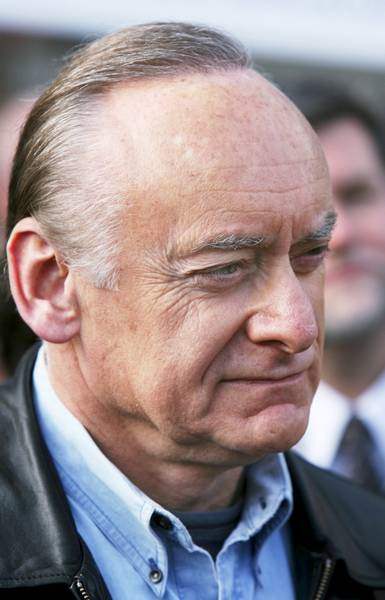
Ohio to plan a new focus on vacant buildings
2/2/2007
Fisher
COLUMBUS - Eight years after he toured the vacant Fiberglas Tower as a gubernatorial candidate, Lt. Gov. Lee Fisher said buildings like this will be the focus of a new Governor's Office of Urban Development and Infrastructure.
He said last night that he and Gov. Ted Strickland are also looking into whether Ohio's existing programs assisting in the cleanup of polluted, abandoned industrial sites might be used to alleviate the asbestos liability of the tower and other buildings of its era.
But the fact that Toledo's second-highest skyscraper is privately owned could complicate matters, he said.
"We have not had a chance to discuss that specific building, but I remember it well from when I toured it eight years ago," he said. "We are committed to Mayor Finkbeiner and the community to do all we can, not just for that building but to urban revitalization in Toledo and the other major cities of the state."
He said the new urban development office would be created soon and would work closely with the Department of Development, of which Mr. Fisher also serves as director.
"We will identify and target resources for the whole area of problem vacant and abandoned industrial buildings and land, and we will develop a more coherent and focused strategy," said Mr. Fisher, a former state senator and attorney general from the Cleveland area.
An Office of Urban Development already exists under the Department of Development that oversees a variety of state and federal grant and revolving loan programs for cleanup and redevelopment of so-called "brownfield" sites. The new office, however, would be elevated to the governor's office instead of a departmental division.

Fisher
As a Democratic candidate for governor in 1998, Mr. Fisher said he favored decentralization of state government and remarked during his tour that the Fiberglas Tower could serve as a good home for state offices. But he made no commitments then and offered none yesterday.
"It would be fair to say that the governor and I are committed to regional economic growth," he said. "We are certainly open to exploring all options."
The state of Ohio has looked beyond the Statehouse, Rhodes Tower, and Vern Riffe Center in downtown Columbus for precious office space in recent years - but it hasn't looked far.
The massive Department of Job and Family Services is in the process of moving 810 of its roughly 4,000 employees from Medicaid, child support, and other operations into the former downtown building once occupied by Lazarus department store. The department recently leased office space for its computer operations in a private building at the Air Center near Port Columbus International Airport under a two-year, $2.7 million lease.
And the Department of Taxation recently leased space in the former Northland Mall north of downtown Columbus under a $3.2 million, two-year lease. But there appears to be no movement toward making significant agency or division relocations from the immediate Columbus environs for Toledo or elsewhere.
The Department of Administrative Services estimates that, of roughly 60,000 state employees, about half work in Franklin County, where Columbus is the county seat.
The Ohio Civil Services Employees Association, the union representing 36,000 of those employees, estimates that just under 11,000 of its members work in Franklin County, with the rest at prisons, parks, employment offices, and other government operations spread across the state. OSCEA counts just over 900 working in Lucas County and 350 in Wood.
"The concern we have is that it's easier to move desks than people," said union spokesman Peter Wray. "If there was a serious attempt to transfer people, it would be awfully hard to imagine it being worked into reality. In cases where people are married, their spouses have jobs here. Being offered the same job and moving expenses is not realistic. There would have to be serious discussion, and there is the potential for a lot of hidden costs, substantial costs."
In Toledo yesterday, officials said the city has made tax abatements and other economic incentives available to help developers try to get Fiberglas Tower habitable. But over the years, most interested parties have shied away from proceeding, after inspecting the building.
Andy Ferrara, manager of real estate for the city of Toledo, said there are ways to cope with the asbestos and heating and air conditioning problems in the building.
"You could condo-ize it," he said, suggesting converting a few floors at a time rather than trying to do the whole building at once.
The city, he said, has been active in trying to find buyers or tenants for the Fiberglas Tower, along with the building's owner, the Eyde Co. and its hired firm, Michael Realty Co. of Toledo.
"We show it to anyone who has an interest and we are working on a potential use for the building even now, one that is strictly our own initiative," he said. "I can't say what that is but we are working on it."
Mayor Carty Finkbeiner has said Fiberglas Tower would be ideal as downtown housing, a business incubator, or for use as the University of Toledo's College of Law.
Mr. Ferrara did not rule out a future acquisition of the building by state, county, or city government, or a combination of all three.
"It's not out of the question," he said.
The value of the tower will increase, he contended, once the city builds a proposed sports arena nearby. That's because the surrounding area will likely get economic spinoff.
"Whether for service industry, office, whatever, that building will be in demand," Mr. Ferrara said.
Blade business writer Jon Chavez contributed to this report.
Contact Jim Provance at:
jprovance@theblade.com
or 614-221-0496.